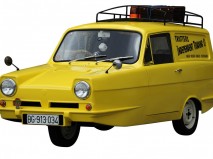1962 Reliant Regal Supervan
Reliant Regal, painted, as in the series Only Fools and Horses.
The Reliant Regal was a small three-wheeled car manufactured from 1953 until 1973 by the Reliant Motor Company in Tamworth, England, replacing the earlier Reliant Regent cyclecar van. It was a three-wheeled vehicle, therefore under UK licensing it was considered a tricycle. Due to the lightweight construction, under seven cwt, the vehicle could be driven on a motorcycle licence in the United Kingdom. A light-commercial version with a side-hinged rear door was marketed as the Reliant Supervan.
Following the launch of the Mk I in 1953, the Regal passed through many revisions in a short period, with the "first generation" using the original wooden frame and discrete-panel bodywork design through to the 1961 Mk VI.[2]
In 1962, Reliant introduced the Mk VII, code named "TW7" (Three Wheeler 7). This version featured a new OHV Reliant engine, a new steel chassis and bonded shell design for the body, fully updated visual styling, and was badged as the Regal 3/25, Regal 3/30 (number of wheels/bhp), Regal 21E or Regal 21E 700. The 600cc engine produced 25 bhp (actually 598cc/24 bhp) and the 700cc engine produced 30 bhp (actually 701cc / 29 bhp). The 21E version was fitted with 21 extras, which were otherwise available as optional extras to the standard car. These extras included a spot light, a fog light, chrome plated bumper over-riders, sun visors, an oil gauge, outer wheel trims and metallic paint. In 1973, the Regal was replaced by the Reliant Robin (code named "TW8").
Regals MkI-MkVI had aluminium bodies and 747cc side-valve engines. However, during the 1950s, the price of aluminium increased markedly across Europe. In response, Reliant developed an expertise in making panels of glass fibre which piece by piece replaced the aluminium panels, until the 1956 Mark 3 Regal featured a wholly glass fibre body.[4] Unlike Panhard, who responded to the increased cost of aluminium by substituting heavier steel panels, Reliant's choice of the glass fibre technology ensured that the Regal was able to retain its advantageous light weight, with the resulting ability to use smaller, lower powered and therefore cheaper and more economical engines. The Regal Mk VI was the last Regal to be powered by a side-valve engine, as by 1962 Reliant had developed their own all aluminium 600 cc OHV engine that was fitted into the new Regal 3/25.
The Regal 3/25 version was introduced in October 1962 and unlike previous Regals, this no longer had a wooden frame and instead had a unitary construction body of reinforced fibreglass. Fibreglass was moulded in two major units (outer and inner) and then bonded together and bolted to a steel chassis. Meanwhile, on 25 April 1968, a year before BMC celebrated their 2,000,000th Mini Reliant sales director T.H.Scott personally drove the 50,000th Regal 3/25 off the assembly line at Reliant's Tamworth plant.
A few months later, in August 1968, the 701 cc engine introduced in the Reliant Rebel the previous Autumn found its way into the Regal. For the three-wheeler, the compression ratio was lowered to 7.5:1, reducing the power to a claimed 29.5 bhp from the Rebel's 35 bhp. Nevertheless, this still represented a useful increase over the 26 bhp claimed for the 600 cc unit which the 701 replaced








